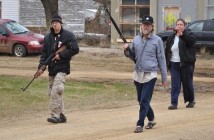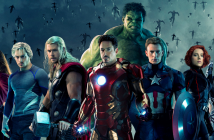Director: Luke Dodd, Michael Whyte
Country: UK
Genre: Documentary
Editor’s Note: The following review is part of our coverage of the 2014 Jameson Dublin International Film Festival. For more information please visit jdiff.com or follow DublinFilmFest on Twitter.
Luke Dodd and Michael Whyte’s documentary about British portrait photographer Jane Bown is impressively candid and intimate. Bown has photographed some of the world’s most famous faces over her career and developed a style that is still incomparable to her contemporaries.
Uncouth and stunning black and white images famous faces captured in a moment of extraordinary spontaneity that manages to portray their famous personality. Her ability to encapsulate something other than the face we see is unique to her style. Her work reveals entirely intimate moments of the personality she’s photographing.
Luke Dodd and Michael Whyte’s documentary about British portrait photographer Jane Bown is impressively candid and intimate.
 Brought up in a middle class English background, Bown is a respectable woman that everybody knew as nothing at all like the other working photographers of her generation. When she started out she carried around a bag full of cameras and wasn’t competitive for her work. She had a flare for framing and her key trait was finding the perfect light.
Brought up in a middle class English background, Bown is a respectable woman that everybody knew as nothing at all like the other working photographers of her generation. When she started out she carried around a bag full of cameras and wasn’t competitive for her work. She had a flare for framing and her key trait was finding the perfect light.
The documentary features countless speakers talking about what type of a personality Bown was and still is. It seems that even in her late age she’s very much the woman she always was. Remarkable tales of her career are told through others who were there with her at the time and in candid little interviews with the woman herself. After a 2005 interview with the photographer, the filmmakers saw the potential of her tale and knew they weren’t anywhere near finished with her yet.
As a photography documentary it’s only fair that the focus is of course on Bown’s imagery. Large cinematic versions of some of her most famous works give dominance and completeness to the feature. As well researched and as well interviewed as the film is, the best work is done in the editing for the inclusion of her portraiture. Each image takes over the entire screen for just enough time to allow the viewer to pause, as if in an art gallery, and admire them for all they are worth.
As well researched and as well interviewed as the film is, the best work is done in the editing for the inclusion of her portraiture. Each image takes over the entire screen for just enough time to allow the viewer to pause, as if in an art gallery, and admire them for all they are worth.
An in depth criticism of Bown’s work in intertwined with the flow of the feature. Art historians and professional photographers, editors from The Guardian where she worked for most of her career, all develop an impressionistic viewpoint of this talented lady. Shapes and textures were her initial inspiration, not so much character studies, but how a body fitted in with its landscape. For a woman who began work in the Navy and afterwards went to Gilford to study photography, she’s come a long way from the disinterested student who despised criticism. As we get to know Bown more personally, a figure envelopes the narrative, full of bright inspiration and determination. She’s a true artist as the film states.
Artist documentaries can be overtly flowery and although keeping a level of respect at all times the documentary that emerges is one of opinion. The images give the viewer a chance to develop their own view of the artist as a person and as a figure of their own importance. It’s as if we’re going to a gallery to see an exhibition on an artist, we take the guided tour and we might buy a book in the gift shop on the way out if we so fancy. Naturally unimposing, it’s the perfect mix of passionate filmmaking and open text reading.
[notification type=”star”]75/100 ~ GOOD. Naturally unimposing, it’s the perfect mix of passionate filmmaking and open text reading.[/notification]



